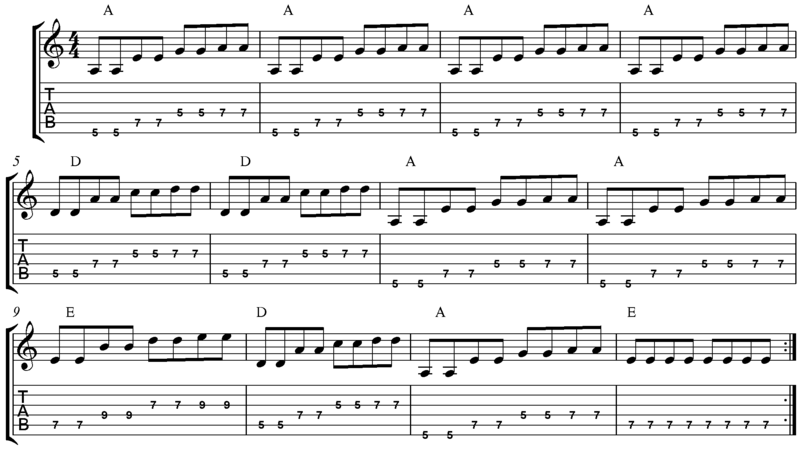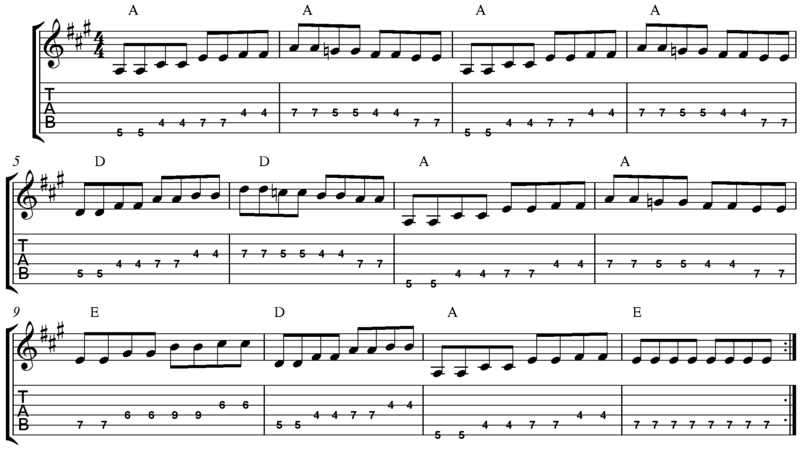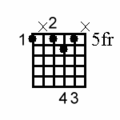Guitar/Blues

Introduction
[edit | edit source]The blues is an American form of music whose origins can be traced back to the African-American communities of the southern states in the early 1900s. Its a music of African performance aesthetics played upon European instruments that not only draws upon a remembered African tradition but also alters the standard technique of each instrument. The uniqueness of this cultural exchange is the result of using established Western musical instruments, such as the tempered piano and fixed-valve trumpet, in a distinctly African micro-tonal and rhythmic context. The opening trumpet solo of "West End Blues", played by Louis Armstrong on a fixed-valve trumpet, illustrates all the points so far stated. In contemporary African music modern instruments of European origin are combined with traditional instruments. The guitars on the song "Djam Leelii" by the West African musicians Baaba Maal and Mansour Seck are the result of the same aesthetic approach. Baaba Maal is firmly rooted in the culture of Senegal and Louis Armstrong in the culture of America. The differences between the two artists reflects the importance of American culture to the development of the blues yet the link to African aesthetics is there for all to hear. The punctuation of percussion at certain points, the rhythmic variation of a single motif, the independence of each musician to temporarily introduce a melodic or rhythmic counterpoint to another part, and the space afforded to improvisation.
The twelve bar blues
[edit | edit source]The twelve bar blues is a simple chord progression that can be easily transposed to different keys. Each box in the diagram below represents one bar with four beats. The roman numeral inside the box indicates which chord is to be played for that bar.
| I | I | I | I |
| IV | IV | I | I |
| V | IV | I | I |
Below are the chords of the key of C major. The I is the tonic chord for which the key is named.
| I | II | III | IV | V | VI | VII | I |
| C | Dm | Em | F | G | Am | Bdim | C |
Substituting the roman numerals with the chords from the key of C major we see that I is a C major chord, IV is an F major chord and V is a G major chord. This is how the boxes look after replacing the roman numerals with the chord names:
| C | C | C | C |
| F | F | C | C |
| G | F | C | C |
Note that the three minor chords and the one diminished chord of the key of C major are not used. The twelve bar blues exercise above consists of only the primary chords.
Basic blues shuffle rhythm
[edit | edit source]This exercise is a twelve bar blues shuffle in A. Observe that the lower note in each bar is always an open string and will be one of the roots of the primary chords I, IV or V.

The minor pentatonic and blues scales
[edit | edit source]The minor pentatonic scale is a five note scale. It can be derived from the natural minor scale by omitting the second and sixth which in this exercise are the notes B and F. The notes of the A minor pentatonic scale are:
A, C, D, E, G, A

In any key, the pattern of intervals in between the notes of this scale is (in half-steps, or guitar frets):
3, 2, 2, 3, 2
So the second note, in this case C, will always be 3 half-steps, or 3 frets, higher than the first note, A. The third note is 2 half-steps or frets higher than the second, and so on. The exercise below allows you to visually map all the notes of the A minor pentatonic scale on the low E string up to the twelfth fret:

Here are two octaves of the A minor pentatonic scale in the 5th position:

The blues scale below is the A minor pentatonic scale with the addition of a flatted fifth. The addition of the diminished fifth introduces an element of dissonance and tension to the scale. In this exercise the flatted fifth blue note acts as a chromatic passing note which resolves to a consonance. Observe that you always refer to the scale degrees of the minor pentatonic scale by the interval names of the natural minor scale. The fourth note of the scale below retains the designation of a fifth whether it is diminished or perfect. The omission of the second and sixth note of the natural minor scale to form the minor pentatonic scale does not alter the interval relationship between the A and E which remains a perfect fifth.

Exercise 1
[edit | edit source]
Exercise 2
[edit | edit source]
Exercise 3
[edit | edit source]Playing The Blues Using Only Seventh Chords
You can use seventh chords when playing the blues. Try the 12 bar blues in A using the chords below. No fingering has been given for the D7 and E7 since they have the same fingering as a C chord.
-
A7
-
D7
-
E7
Further blues exercises can be found in the appendix Blues Exercises



